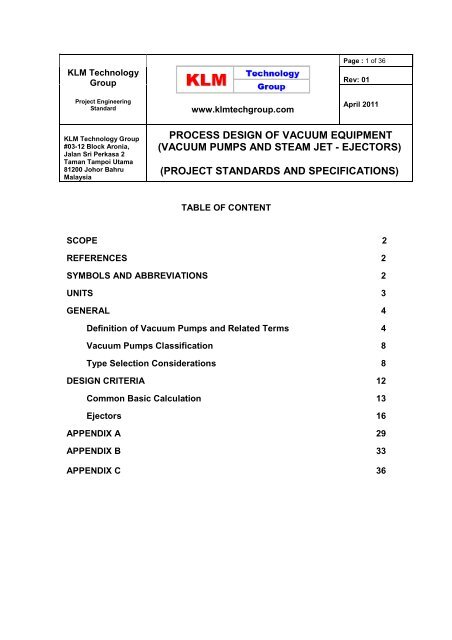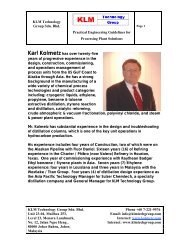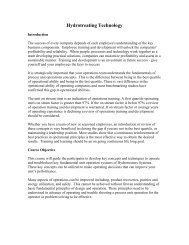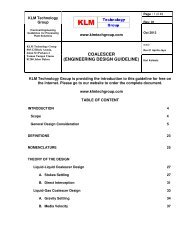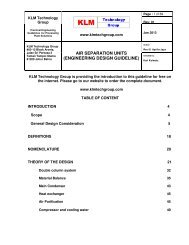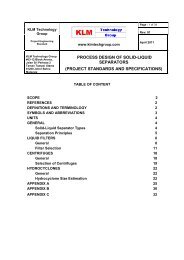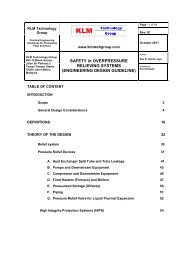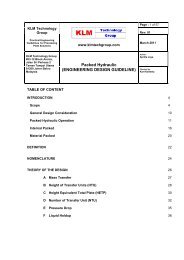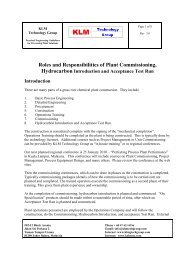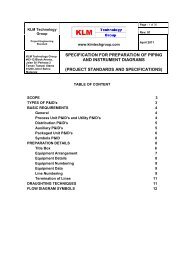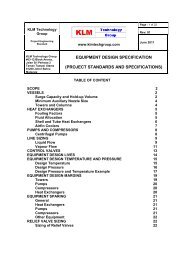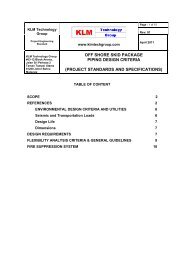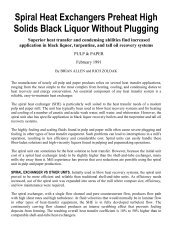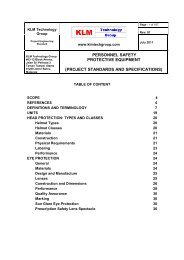process design of vacuum equipment - KLM Technology Group
process design of vacuum equipment - KLM Technology Group
process design of vacuum equipment - KLM Technology Group
Create successful ePaper yourself
Turn your PDF publications into a flip-book with our unique Google optimized e-Paper software.
<strong>KLM</strong> <strong>Technology</strong><strong>Group</strong>Page : 1 <strong>of</strong> 36Rev: 01Project EngineeringStandardwww.klmtechgroup.comApril 2011<strong>KLM</strong> <strong>Technology</strong> <strong>Group</strong>#03-12 Block Aronia,Jalan Sri Perkasa 2Taman Tampoi Utama81200 Johor BahruMalaysiaPROCESS DESIGN OF VACUUM EQUIPMENT(VACUUM PUMPS AND STEAM JET - EJECTORS)(PROJECT STANDARDS AND SPECIFICATIONS)TABLE OF CONTENTSCOPE 2REFERENCES 2SYMBOLS AND ABBREVIATIONS 2UNITS 3GENERAL 4Definition <strong>of</strong> Vacuum Pumps and Related Terms 4Vacuum Pumps Classification 8Type Selection Considerations 8DESIGN CRITERIA 12Common Basic Calculation 13Ejectors 16APPENDIX A 29APPENDIX B 33APPENDIX C 36
<strong>KLM</strong> <strong>Technology</strong><strong>Group</strong>Project Engineering StandardSCOPEPROCESS DESIGN OF VACUUMEQUIPMENT(VACUUM PUMPS AND STEAMJET - EJECTORS)(PROJECT STANDARDS ANDSPECIFICATIONS)Page 2 <strong>of</strong> 36Rev: 01April 2011This Project Standards and Specifications is intended to cover guidelines forselection <strong>of</strong> proper type <strong>vacuum</strong> system, <strong>process</strong> calculation stages for <strong>vacuum</strong>systems including capacity, estimation <strong>of</strong> air leakage and rough estimation <strong>of</strong>utility consumption and a typical P & I diagram for a <strong>vacuum</strong> system.REFERENCESThroughout this Standard the following dated and undated standards/codes arereferred to. These referenced documents shall, to the extent specified herein,form a part <strong>of</strong> this standard. For dated references, the edition cited applies. Theapplicability <strong>of</strong> changes in dated references that occur after the cited date shallbe mutually agreed upon by the Company and the Vendor. For undatedreferences, the latest edition <strong>of</strong> the referenced documents (including anysupplements and amendments) applies.1. Heat Exchange Institute Inc."Standard for Steam Jet Ejectors", 3rd. Ed. 1980"General Construction Standard for Ejector Componenetsother than Ejector Condensers", 1st. Ed.2. ISO (International Organization for Standardization)3529/2 "Vacuum <strong>Technology</strong>-Vocabulary" Part 2: "Vacuum Pumpsand Related Terms"1st. Ed. 1981SYMBOLS AND ABBREVIATIONSSYMBOL/ABBREVIATIONDESCRIPTIONAQuotational PriceBSteam Cost Per TonC Cooling Water Cost Per 1000 m 3FCapital Charge Percentageg Acceleration <strong>of</strong> Gravity = 9.806 m/s 2G sG wHSteam Consumption, Tons Per Year in (t/a)Cooling Water Consumption, in (1000 m 3 /a)Height, in (meters)
<strong>KLM</strong> <strong>Technology</strong><strong>Group</strong>Project Engineering StandardPROCESS DESIGN OF VACUUMEQUIPMENT(VACUUM PUMPS AND STEAMJET - EJECTORS)(PROJECT STANDARDS ANDSPECIFICATIONS)Page 3 <strong>of</strong> 36Rev: 01April 2011LM nM vP 1P 2P cP nP oAir Leakage, in (kg/h)Molecular Mass <strong>of</strong> Noncondensable Gas, in(kg/kmol)Molecular Mass <strong>of</strong> Condensable Vapor, in(kg/kmol)Initial Pressure in System, in [mm Hg (abs.)]Final Pressure in System, in [mm Hg (abs.)]Condensate Pressure in Condenser, in (kPa)Partial Pressure <strong>of</strong> Non-Condensable Gas, in [mmHg (abs.)]Barometric Pressure at Liquid Level, in (kPa)P vPartial Pressure <strong>of</strong> Condensable Vapor, in [mm Hg(abs.)]QThroughput <strong>of</strong> a Vacuum Pump, in (Pa. m 3 /s)SVolume Flow Rate <strong>of</strong> a Vacuum Pump, in (m 3 /s)TAbsolute Temperature, in (K)V Volume, in (m 3 )WCapacity <strong>of</strong> Ejector, in (kg/h)tTime, in (h)Mass Flow Rate <strong>of</strong> Non-Condensable Gas, in (kg/h)W nW vMass Flow Rate <strong>of</strong> Condensable Vapor, in (kg/h)uPPressure Difference due to Friction Losses, in (kPa)ρ L Mass Density <strong>of</strong> Liquid, in (kg/m 3 )UNITSThis Standard is based on International System <strong>of</strong> Units (SI) except whereotherwise specified.
<strong>KLM</strong> <strong>Technology</strong><strong>Group</strong>Project Engineering StandardGENERALPROCESS DESIGN OF VACUUMEQUIPMENT(VACUUM PUMPS AND STEAMJET - EJECTORS)(PROJECT STANDARDS ANDSPECIFICATIONS)Page 4 <strong>of</strong> 36Rev: 01April 2011Vacuum <strong>equipment</strong>, as called by ISO (International Organization forStandardization),"Vacuum Pumps", are defined as devices for creating,improving and/or maintaining a <strong>vacuum</strong>.In Oil and Gas Processing industries the name "Vacuum Pump" is conventionallyused for rotating machine <strong>vacuum</strong> devices and <strong>vacuum</strong> <strong>equipment</strong> are dividedinto two main groups, Vacuum Pumps and Steam Ejectors.Definition <strong>of</strong> Vacuum Pumps and Related TermsDefinitions <strong>of</strong> <strong>vacuum</strong> pumps and related terms <strong>of</strong> ISO-3529/2, are generallyaccepted in this Standard. The following selected definitions are recommendedemphatically.1. Vacuum pumpA device for creating, improving and/or maintaining a <strong>vacuum</strong>. Two basicallydistinct categories may be considered: gas transfer pumps and entrapment orcapture pumps2. Positive displacement (<strong>vacuum</strong>) pumpA <strong>vacuum</strong> pump in which a volume filled with gas is cyclically isolated fromthe inlet, the gas being then transferred to an outlet. In most types <strong>of</strong> positivedisplacement pumps the gas is compressed before the discharge at theoutlet. Two categories can be considered: reciprocating positive displacementpumps and rotary positive displacement pumps.3. Oil - sealed (liquid - sealed) <strong>vacuum</strong> pumpA rotary positive displacement pump in which oil is used to seal the gapbetween parts which move with respect to one another and to reduce theresidual free volume in the pump chamber at the end <strong>of</strong> the compression part<strong>of</strong> the cycle.4. Dry - sealed <strong>vacuum</strong> pumpA positive displacement pump which is not oil-sealed (liquid-sealed).5. Piston <strong>vacuum</strong> pumpA positive displacement pump in which the gas is compressed and expelleddue to the movement <strong>of</strong> a reciprocating piston moving in a cylinder.
<strong>KLM</strong> <strong>Technology</strong><strong>Group</strong>Project Engineering StandardPROCESS DESIGN OF VACUUMEQUIPMENT(VACUUM PUMPS AND STEAMJET - EJECTORS)(PROJECT STANDARDS ANDSPECIFICATIONS)Page 5 <strong>of</strong> 36Rev: 01April 20116. Liquid ring <strong>vacuum</strong> pumpA rotary positive displacement pump in which an eccentric rotor with fixedblades throws a liquid against the stator wall. The liquid takes the form <strong>of</strong> aring concentric to the stator and combines with the rotor blades to define avarying volume.7. Sliding vane rotary <strong>vacuum</strong> pumpA rotary positive displacement pump in which an eccentrically placed rotor isturning tangentially to the fixed surface <strong>of</strong> the stator. Two or more vanessliding in slots <strong>of</strong> the rotor (usually radial) and rubbing on the internal wall <strong>of</strong>the stator, divide the stator chamber into several parts <strong>of</strong> varying volume.8. Roots <strong>vacuum</strong> pumpA positive displacement pump in which two lobed rotors, interlocked andsynchronized, rotate in opposite directions moving past each other and thehousing wall with a small clearance and without touching.9. Kinetic <strong>vacuum</strong> pumpA <strong>vacuum</strong> pump in which a momentum is imparted to the gas or themolecules in such a way that the gas is transferred continuously from the inletto the outlet. Two categories can be considered: fluid entrainment pumps anddrag <strong>vacuum</strong> pumps.10.Ejector <strong>vacuum</strong> pumpA kinetic pump which use the pressure decrease due to a Venturi effect andin which the gas is entrained in a high-speed stream towards the outlet. Anejector pump operates when viscous and intermediate flow conditions obtain.11.Liquid jet <strong>vacuum</strong> pumpAn ejector pump in which the entrainment fluid is a liquid (usually water).12.Gas jet <strong>vacuum</strong> pumpAn ejector pump in which the entrainment fluid is a noncondensable gas.13.Vapor jet <strong>vacuum</strong> pumpAn ejector pump in which the entrainment fluid is a vapor (water, mercury orother vapor).14.Diffusion pumpA kinetic pump in which a low pressure, high-speed vapor stream providesthe entrainment fluid. The gas molecules diffuse into this stream and aredriven to the outlet. The number density <strong>of</strong> gas molecules is always low in thestream. A diffusion pump operates when molecular flow conditions obtain.
<strong>KLM</strong> <strong>Technology</strong><strong>Group</strong>Project Engineering StandardPROCESS DESIGN OF VACUUMEQUIPMENT(VACUUM PUMPS AND STEAMJET - EJECTORS)(PROJECT STANDARDS ANDSPECIFICATIONS)Page 6 <strong>of</strong> 36Rev: 01April 201115.Entrapment [capture] <strong>vacuum</strong> pumpA <strong>vacuum</strong> pump in which the molecules are retained by sorption orcondensation on internal surfaces.16.InletThe port by which gas to be pumped enters a pump, also called "SuctionChamber", (see Fig. 6).17.OutletThe outlet or discharge port <strong>of</strong> a pump.18.Pump fluidThe operating fluid <strong>of</strong> an ejector or diffusion pump.19.Steam chestThe compartment between the motive steam inlet port and the nozzle inlet (ornozzle plate) <strong>of</strong> an ejector, (see Fig. 6).20.Nozzle plateThe plate on which nozzles (or nozzle extensions) <strong>of</strong> an ejector are mounted,(see Fig. 6).21.NozzleThe part <strong>of</strong> an ejector or diffusion pump used to direct the flow <strong>of</strong> the pumpfluid in order to produce the pumping action.22.Nozzle throatSmallest cross-section <strong>of</strong> the nozzle.23.Nozzle extensionThe part (a small piece <strong>of</strong> pipe) between steam chest (or nozzle plate) andthe nozzle, (see Fig. 6).24.Nozzle clearance areaThe smallest cross-sectional area between the outer rim <strong>of</strong> a nozzle and thewall <strong>of</strong> the pump casing.25.Nozzle clearanceThe width <strong>of</strong> the annulus determining the nozzle clearance area.26.JetThe stream <strong>of</strong> pump fluid issuing from a nozzle, in an ejector or diffusionpump.27.DiffuserThe converging section <strong>of</strong> the wall <strong>of</strong> an ejector pump.
<strong>KLM</strong> <strong>Technology</strong><strong>Group</strong>Project Engineering StandardPROCESS DESIGN OF VACUUMEQUIPMENT(VACUUM PUMPS AND STEAMJET - EJECTORS)(PROJECT STANDARDS ANDSPECIFICATIONS)Page 7 <strong>of</strong> 36Rev: 01April 201128.Diffuser throatThe part <strong>of</strong> a diffuser having the smallest cross-sectional area.29.Volume flow rate <strong>of</strong> a <strong>vacuum</strong> pump [symbol: S; unit: m 3 .s -1 ]It is the volume flow rate <strong>of</strong> the gas removed by the pump from the gas phasewithin the evacuated chamber. This kind <strong>of</strong> definition is only applicable topumps which are distinct devices, separated from the <strong>vacuum</strong> chamber. Forpractical purposes, however, the volume flow rate <strong>of</strong> a given pump for a givengas is, by convention , taken to be the throughput <strong>of</strong> the gas flowing from astandardized test dome connected to the pump, divided by the equilibriumpressure measured at a specified position in the test dome, and underspecified conditions <strong>of</strong> operation.30.Throughput <strong>of</strong> a <strong>vacuum</strong> pump [symbol: Q; unit: Pa.m 3 .s -1 ]The throughput flowing through the inlet <strong>of</strong> the pump.31.Starting pressurePressure at which a pump can be started without damage and a pumpingeffect can be obtained.32.Backing pressureThe pressure at the outlet <strong>of</strong> a pump which discharges gas to a pressurebelow atmospheric.33.Critical backing pressureThe backing pressure above which a vapor jet or diffusion pump fails tooperate correctly. It is the highest value <strong>of</strong> the backing pressure at which asmall increment in the backing pressure does not yet produce a significantincrease <strong>of</strong> the inlet pressure. The critical backing pressure <strong>of</strong> a given pumpdepends mainly on the throughput.Note:For some pumps the failure does not occur abruptly and the critical backingpressure cannot then be precisely stated.34.Maximum backing pressureThe backing pressure above which a pump can be damaged.35.Maximum working pressureThe inlet pressure corresponding to the maximum gas flow rate that the pumpis able to withstand under continuous operation without any deterioration ordamage.
<strong>KLM</strong> <strong>Technology</strong><strong>Group</strong>Project Engineering StandardPROCESS DESIGN OF VACUUMEQUIPMENT(VACUUM PUMPS AND STEAMJET - EJECTORS)(PROJECT STANDARDS ANDSPECIFICATIONS)Page 8 <strong>of</strong> 36Rev: 01April 201136.Ultimate pressure <strong>of</strong> a pumpThe value towards which the pressure in standardized test dome tendsasymptotically, without introduction <strong>of</strong> gas and with the pump operatingnormally. A distinction may be made between the ultimate pressure due onlyto noncondensable gases and the total ultimate pressure due to gases andthe total ultimate pressure due to gases and vapors.37.Operating pressureThe absolute pressure, expressed in mm Hg or kPa(abs.), that a <strong>vacuum</strong>pump or ejector unit can maintain in a system operating at <strong>design</strong> capacityand normal operating conditions.38.Compression ratioThe ratio <strong>of</strong> the outlet pressure to the inlet pressure, for a given gas.Vacuum Pumps ClassificationISO classification <strong>of</strong> <strong>vacuum</strong> <strong>equipment</strong> (<strong>vacuum</strong> pumps) is shown in Fig. 1.Type Selection ConsiderationsVacuum <strong>equipment</strong> can be roughly divided into "Steam Ejectors" and "VacuumPumps", as mentioned in previous sections. Three major factors should beconsidered in the type selection stage for <strong>vacuum</strong> devices. These factors areoperating requirements (i.e., suction pressure), suction gas properties and cost.As a general procedure for type selection, the flow chart shown in Fig. 2 can beused.1. Operating conditionsApplication range <strong>of</strong> different type <strong>of</strong> <strong>vacuum</strong> <strong>equipment</strong> can be found in Fig.3.In selecting the type <strong>of</strong> <strong>vacuum</strong> pump, the characteristics <strong>of</strong> the individualtypes and the <strong>process</strong> conditions involved must be fully considered. Contactwith the vendors is also necessary. The characteristics <strong>of</strong> <strong>vacuum</strong> pumps aregiven in Table. 1.For ejector, once the operating pressure is determined, the number <strong>of</strong> stagescan be determined from Fig. 3.2. Comparison <strong>of</strong> costsGenerally speaking, steam ejectors require less initial cost and have nomoving parts, and hence they have high reliability. On the other hand, their
<strong>KLM</strong> <strong>Technology</strong><strong>Group</strong>Project Engineering StandardPROCESS DESIGN OF VACUUMEQUIPMENT(VACUUM PUMPS AND STEAMJET - EJECTORS)(PROJECT STANDARDS ANDSPECIFICATIONS)Page 9 <strong>of</strong> 36Rev: 01April 2011disadvantage is that their utility cost is high. Meanwhile, in the case <strong>of</strong><strong>vacuum</strong> pumps, although they cost 5 to 20 times as much as steam ejectorsand require high maintenance cost, their utility cost is lower.Regarding the operating costs, a general measure will be that, where thesuction gas volume is large and the operating pressure is high, <strong>vacuum</strong>pumps will require less operating cost than steam ejectors.3. Properties <strong>of</strong> suction gasa. In the case <strong>of</strong> steam ejectors which produce a large quantity <strong>of</strong> wasteliquid, their use will be disadvantageous unless the cost <strong>of</strong> the waste liquidtreatment is cheap.b. Where corrosive gases must be handled, steam ejectors, which can bemanufactured <strong>of</strong> almost any material, will be advantageous.Fig. 1 Classification Table <strong>of</strong> Vacuum Pumps
<strong>KLM</strong> <strong>Technology</strong><strong>Group</strong>Project Engineering StandardPROCESS DESIGN OF VACUUMEQUIPMENT(VACUUM PUMPS AND STEAMJET - EJECTORS)(PROJECT STANDARDS ANDSPECIFICATIONS)Page 10 <strong>of</strong> 36Rev: 01April 2011Fig. 2 Selection Procedure for Vacuum Equipment
<strong>KLM</strong> <strong>Technology</strong><strong>Group</strong>Project Engineering StandardPROCESS DESIGN OF VACUUMEQUIPMENT(VACUUM PUMPS AND STEAMJET - EJECTORS)(PROJECT STANDARDS ANDSPECIFICATIONS)Page 11 <strong>of</strong> 36Rev: 01April 2011
<strong>KLM</strong> <strong>Technology</strong><strong>Group</strong>Project Engineering StandardPROCESS DESIGN OF VACUUMEQUIPMENT(VACUUM PUMPS AND STEAMJET - EJECTORS)(PROJECT STANDARDS ANDSPECIFICATIONS)Page 12 <strong>of</strong> 36Rev: 01April 2011TypeRECIPROCATINGOne StageTwo StageNASH(Water seal)RootsOne stageTwo stageRotary(Oil seal )MechanicalboosterNote:Fig. 3 Application Range <strong>of</strong> Vacuum EquipmentTable 1 Characteristic <strong>of</strong> Various Vacuum PumpsOperatingPressure*(mm Hg)5 - 760Suitability forSuction GasSt'm Low- DustBoil'gGas+++NoteCorrosive gases can be handled.Required largeSpace for installation.10 -1 - 76050 - 760 + + Suitable for chemical Processes.Consumes much power.Liquid sealed circuit necessary.300 - 760100 - 760++++Large exchaust volumeConsumes much power.10 -4 - 760 --- --- Low resistance against corrosivegases.10 -3 - 10 + Large exchaust volum.Consumes less power.Auxiliary pumps necessary.* It is possible to lower operating pressure by adopting heavy liquid sealing.+ Strong.Slightly strong.Slightly weak.- Weak.DESIGN CRITERIAThe basic <strong>design</strong> stage <strong>of</strong> <strong>vacuum</strong> pumps and ejectors, can be divided into twodistinct parts, first is the calculation <strong>of</strong> parameters or factors which are commonfor all <strong>vacuum</strong> devices, such as those concerning the suction conditions. On theother hand, there are some calculations which regards specifically on; and differsfor; each <strong>equipment</strong> type. In the following sections, each part is individuallydiscussed, except that since <strong>vacuum</strong> pumps are considered principally ascompressors, no special basic calculation method for this type is presented here.Typical P&I diagrams for <strong>vacuum</strong> pump and ejector <strong>vacuum</strong> systems are shownin Appendix B.
<strong>KLM</strong> <strong>Technology</strong><strong>Group</strong>Project Engineering StandardPROCESS DESIGN OF VACUUMEQUIPMENT(VACUUM PUMPS AND STEAMJET - EJECTORS)(PROJECT STANDARDS ANDSPECIFICATIONS)Page 13 <strong>of</strong> 36Rev: 01April 2011Common Basic CalculationThe following procedure should be followed for calculating the suctionparameters required to fix a <strong>vacuum</strong> system and to <strong>design</strong> the <strong>equipment</strong>basically.a. Determine <strong>vacuum</strong> required at the critical <strong>process</strong> point in the system.b. Calculate pressure drop from this point to the <strong>process</strong> location <strong>of</strong> the suctionflange <strong>of</strong> the first stage <strong>vacuum</strong> <strong>equipment</strong>.c. At the <strong>vacuum</strong> device suction condition determine:i) Kilogram per hour <strong>of</strong> condensable vapor.ii) Kilogram per hour <strong>of</strong> non-condensable gases which are:- dissolved- injected or carried in the <strong>process</strong>- formed by reaction- air leakage1. Suction pressureThe suction pressure <strong>of</strong> a <strong>vacuum</strong> device is expressed in absolute units. If itis given as millimeters <strong>of</strong> <strong>vacuum</strong> it must be converted to absolute units byusing the local or reference barometer.In actual operation suction pressure follows the ejector capacity curve,varying with the non-condensable and vapor load to the unit.2. Discharge pressureAs indicated, performance <strong>of</strong> a <strong>vacuum</strong> unit is a function <strong>of</strong> backpressure. Inorder to insure proper performance, the atmospheric discharge units shall be<strong>design</strong>ed for a back pressure <strong>of</strong> 6 kPa (ga.) unless otherwise specified. Thepressure drop through any discharge piping and aftercooler must be takeninto consideration. Discharge piping should not have pockets forcondensation.3. Capacity <strong>of</strong> the unitThe capacity <strong>of</strong> a <strong>vacuum</strong> unit is expressed as kilograms per hour total <strong>of</strong>non-condensable plus condensables to the inlet flange <strong>of</strong> the unit. Formultistage ejector units, the total capacity must be separated into kilogramsper hour <strong>of</strong> condensables and noncondensables. The final stages are onlyrequired to handle the non condensable portion <strong>of</strong> the load plus the saturationmoisture leaving the intercondensers.


